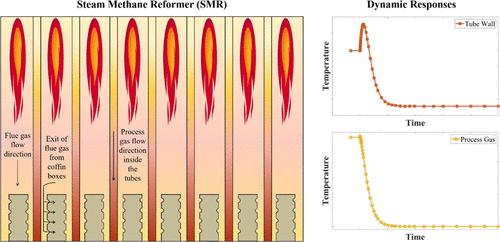基于简化辐射模型的顶燃蒸汽甲烷重整炉物理动力学建模
IF 3.9
3区 工程技术
Q2 ENGINEERING, CHEMICAL
引用次数: 0
摘要
为了实现实时优化和控制,针对传统几何形状的蒸汽甲烷重整器(smr)开发了一种动态的、基于物理的模型,提供了一个灵活的框架,可适应复杂的几何形状和不同的操作条件。与计算流体动力学(CFD)模型不同,这种方法减少了计算时间,使其成为在线监测的理想选择。该模型将重整器划分为温度和组成均匀的区域,并为每个区域制定质量、能量和动量平衡。采用简化交换面积计算的“旅馆区法”对辐射传热进行了分析。对稳态实验数据的验证证实了模型的准确性,与交换面积计算有关的小偏差。定量评估得出氢摩尔分数的均方根误差(RMSE)为0.0156,管外壁温度的均方根误差(RMSE)为24.84 K,计算相对于沿炉高的横截面的平均轮廓。通过动态求解非线性微分代数方程(DAEs),该模型预测了过程和燃烧气体的温度、成分和压力分布,以及管壁温度。它捕捉瞬态行为,时间常数分别为46、40和24分钟,用于过程气体成分变化、流量减少和燃烧器故障。由于一个燃烧器或管排的温度波动会影响相邻排,因此强调了重整器子系统之间的动态相互作用。该模型通过在扰动期间保持安全的管壁温度来支持动态平衡,实现有针对性的燃料再分配,以减少温度不均匀性,提高允许运行温度,并提高重整器效率。本文章由计算机程序翻译,如有差异,请以英文原文为准。

Physics-Based Dynamic Modeling of Top-Fired Steam Methane Reforming Furnaces Integrating a Simplified Radiation Model
A dynamic, physics-based model has been developed for steam methane reformers (SMRs) with conventional geometries to enable real-time optimization and control, offering a flexible framework adaptable to complex geometries and different operational conditions. Unlike computational fluid dynamics (CFD) models, this approach reduces computation time, making it ideal for online monitoring. The model divides the reformer into zones with uniform temperature and composition, formulating mass, energy, and momentum balances for each zone. Radiative heat transfer is analyzed using the Hottel-zone method with simplified exchange area calculations. Validation against steady-state experimental data confirms the model’s accuracy, with minor deviations linked to exchange area calculations. The quantitative assessment yielded a root mean squared error (RMSE) of 0.0156 for the hydrogen mole fraction and 24.84 K for the tube outer wall temperature, calculated with respect to the averaged profiles across cross sections along the furnace height. By solving nonlinear differential-algebraic equations (DAEs) dynamically, the model predicts temperature, composition, and pressure profiles of process and combustion gases, plus tube wall temperature. It captures transient behaviors, with time constants of 46, 40, and 24 min for process gas composition changes, flow reduction, and burner failure, respectively. Dynamic interactions between reformer subsystems are emphasized, as temperature fluctuations in one burner or tube row affect adjacent rows. The model supports dynamic balancing by maintaining safe tube wall temperatures during disturbances, enabling targeted fuel redistribution to reduce temperature nonuniformities, increase allowable operating temperatures, and improve reformer efficiency.
求助全文
通过发布文献求助,成功后即可免费获取论文全文。
去求助
来源期刊

Industrial & Engineering Chemistry Research
工程技术-工程:化工
CiteScore
7.40
自引率
7.10%
发文量
1467
审稿时长
2.8 months
期刊介绍:
ndustrial & Engineering Chemistry, with variations in title and format, has been published since 1909 by the American Chemical Society. Industrial & Engineering Chemistry Research is a weekly publication that reports industrial and academic research in the broad fields of applied chemistry and chemical engineering with special focus on fundamentals, processes, and products.
 求助内容:
求助内容: 应助结果提醒方式:
应助结果提醒方式:


